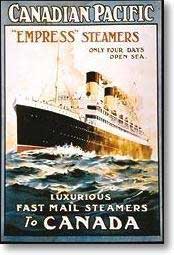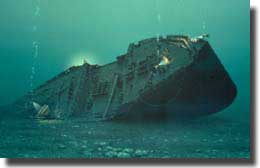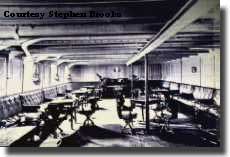Introduction.
The Empress of Ireland came from the same stable as the Empress of Britain. Launched in 1906, being built by Fairfield Shipbuilding and Engineering of Glasgow, Scotland. She steamed out of Liverpool to start her maiden voyage on the 29th. of June, 1906, bound for Quebec. The only route this ship ever plied was the Liverpool/Canada service.

Empress of Ireland, sunk on the 29th. of May 1914, after a collision with the Norwegian Collier Storstad.
Eight Years later.
Almost eight years later, on the 29th. of May, in 1914, we find the Empress steaming in the Saint Lawrence River, Canada, having sailed from Quebec on the eastern leg of her return voyage to England. She had just dropped off the pilot at Farther Point, and was still close to the shore line.

A poster advertising the Empress steamers
The time was 0200 ( 2 AM ), it was a calm night, with Captain Henry Kendall on his bridge of the Empress of Ireland, he had just sighted a ship steaming towards him. In his judgement this ship was about 8 miles away ( remember in 1914, no Radar to aid a Captain, or his Officer of the Watch ) well clear to allow him to navigate his ship across her bows, he could then alter course to make for the open sea.

Captain Henry Kendall, Master of Empress of Ireland.
He gave orders to carry out this move, and crossed as planned, an alteration of course to starboard now meant that both ships would pass starboard side to starboard side. The approaching ship was a Collier, and proved to be the Norwegian, Storstad, she was 440 feet long, a sturdy 6,028 tons crammed to her plimsol line with coal, and she was due to pick up her Pilot for the western run up river to Montreal. Storstad was also hugging the coast line of the Saint Lawrence River.
Just after the Empress had taken up her new course, an incoming fog bank swallowed up both ships.
Passengers aboard the Empress of Ireland.
The passenger lists in the Empress recorded 87 in First Class, 253 in Second Class, and the majority of 717 in Third Class. The lower the class one travelled, the lower in the ship would your cabin be located, thus all the first class passengers would enjoy the ship's upper decks, whilst those in third class would be relegated to decks in the bowels of the vessel.
Salvation Army passengers.
Amongst all the passengers were a group, all members of the Salvation Army, some 170 of them, led by Commissioner David Rees, who had his wife and children with him. They were all off to London to attend a Salvo's convention.

Salvation Army Commissioner David Rees, died in Empress of Ireland,
along with his wife and two of their children.
The time of 0200 ( 2 AM )
Given the time of 0200 ( 2 AM ) most of the passengers and crew off watch had already turned in for the night, and were then sound asleep.
Fog concerns Captain Kendall.
As all Captains at sea react to the sudden arrival of fog, Captain Kendall fretted about the lack of visibility, he was concerned for the safety of both his ship, crew and passengers. He decided his put his engines astern to take the way off his ship, in accordance with the Rules of the Road at Sea, when maneouvering in the company of other ships, when he ordered the engines astern, he sounded three blasts on the ship's siren. ( 1 blast, indicates a ship is turning to starboard, 2 blasts, indicates a ship is turning to port, and 3 blasts, indicates a ship is going astern )
The 14,191 ton Empress of Ireland slowed, almost stopped, but still had some forward way on, suddenly, out of the murk two masthead lights appeared to starboard. The Collier Storstad was heading straight for the Empress, Captain Kendall quickly ordered a sharp alteration of course to starboard, alas too late.
The sharp bows of the Norwegian ship sliced into the Empress slap amidships between her two funnels, just as if the passenger ship were a huge slab of butter. The fully loaded Storstad punched into the Empress below her waterline, entering her for about 25 feet, and opening up a gaping hole some 14 feet wide.

Norwegian Collier Storstad after the collision with the Empress of Ireland
Water rushed into the starboard side, and Empress of Ireland quickly took on a list to starboard, open port holes which should have been closed at sea, allowed the ingress of even more water. The damage precluded the closing of water tight doors, compounding the problems the ship faced. Within 10 minutes the liner lay on her side, some passengers who had managed to escape, perched on her hull. One passenger commented "It was like sitting on the beach, and watching the tide come in!" There was only time to lower four of the lifeboats. Many of the passengers were trapped below in the lower decks, unable to escape in time.

Survivors cling to the upturned hull of the Empress of Ireland
The Empress of Ireland sinks.
Within 14 minutes the Empress was gone, to lay 150 feet below on the muddy bottom of the Saint Lawrence River. 1,012 died, eight more than in the Titanic disaster.
Among the dead were 150 from members of the Salvation Army, including Commissioner David Rees, his wife and two of their children.
Captain Henry Kendall survives.
Captain Kendall did survive, and when hauled on board Storstad, uttered:
"You have sunk my ship."
Marine Court of Inquiry.
The British Admiralty Judge, Lord Mersey presided over the investigation into the cause of this disaster. The English Barrister, Butler Aspinall KC, represented the interests of the owners of the Empress of Ireland, Canadian Pacific, 64 witnesses were called and the Court placed the main blame upon Storstad, the Norwegians disagreed, saying that by going astern Captain Kendall had placed his ship in the way of Storstad. This plea was to no avail, the Court ordered he Norwegian Company of A.F. Klaveness to pay Canadian Pacific's damage claims.
But the owners of Storstad were unable to meet these payments, and were forced to sell their ship.

Wreck of Empress of Ireland
Canadian Pacific hires a Salvage Company.
Just weeks after this disaster, the owners of the Empress of Ireland, Canadian Pacific, hired a salvage company to find and recover from the wreck, the Purser's safe, all the First Class Mail carried onboard, and silver bullion valued then at $150,000. ( at today's values, some 2 Million.) This salvage operation was successful.
The wreck.
The Empress sits in about 150 feet of water on the muddy bottom of the Saint Lawrence River, which even in Summer maintains a low temperature of 34 degrees F, and here the tide runs at 5 knots, giving limited visibility in, and over the wreck. None the less, many experienced divers have dived upon her, since the wreck was found in the mid 1980's.
Captain Kendall survived WW1.
The unlucky Captain Henry Kendall went to sea over WW1, was torpedoed, but again survived, to prove to be lucky in the end. He lived until the 27th. of November in 1965, when he died in a London Nursing ome.
Last survivor of the Empress of Ireland.
The last survivor of this tragic accident at sea in 1914, lived on until the 15th. of May 1995, when Grace Hanagan Martyn died.
Conclusion.
As previously noted, the number of deaths from this dreadful Maritime disaster was greater than the loss of life in the Titanic sinking. But in general, this tragedy at sea in 1914 is not much remembered, the more glamorous Titanic, and her sinking by an iceberg, always seems to attract the headlines, especially after her wreck was found, and then the movie was made.
The Empress was about 2/3 the size of Titanic, and was not without her charm, the 1st. Class Dining Room for example, was very well appointed. It measured 65 feet wide by 58 feet long, was upholstered in red, the woodwork there was gilded, it featured ornate sculpted ceilings, had fixtures made from cut glass, plus an atrium soaring up two levels to the music room.

3rd class dining Room, Empress of Ireland
This work seeks to redress in some small way, the paucity of recorded history of a proud ship who was unlucky to be sunk accidentally in a fog back in 1914.
We remember the Empress of Ireland with affection, and are conscious of those who died that night.

A painting on glass, of the Norwegian Collier Storstad bearing down on the Empress of Ireland,
just before the fatal collision that took over 1,000 lives in 1914.
Julie Bates from Austin,Texas has kindly shared her treasure with me.









